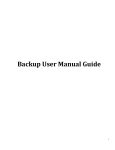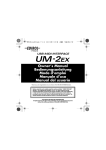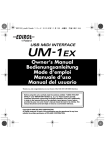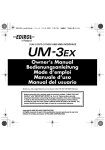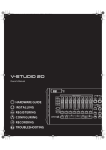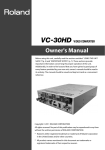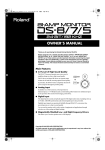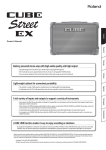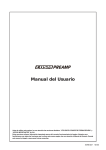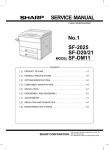Download Roland UM-1G Owner`s manual
Transcript
UM-1G_e.book 1 ページ 2008年11月11日 火曜日 午後6時30分 UM-1G_e.book 2 ページ 2008年11月11日 火曜日 午後6時30分 201a, 202 Before using this unit, carefully read the sections entitled: “USING THE UNIT SAFELY” and “IMPORTANT NOTES” (p. 3; p. 5). These sections provide important information concerning the proper operation of the unit. Additionally, in order to feel assured that you have gained a good grasp of every feature provided by your new unit, Owner’s manual should be read in its entirety. The manual should be saved and kept on hand as a convenient reference. Copyright © 2008 ROLAND CORPORATION All rights reserved. No part of this publication may be reproduced in any form without the written permission of ROLAND CORPORATION. 2 UM-1G_e.book 3 ページ 2008年11月11日 火曜日 午後6時30分 USING THE UNIT SAFELY The symbol alerts the user to important instructions or warnings.The specific meaning of the symbol is determined by the design contained within the triangle. In the case of the symbol at left, it is used for general cautions, warnings, or alerts to danger. Used for instructions intended to alert the user to the risk of death or severe injury should the unit be used improperly. Used for instructions intended to alert the user to the risk of injury or material damage should the unit be used improperly. * Material damage refers to damage or other adverse effects caused with respect to the home and all its furnishings, as well to domestic animals or pets. 002a • The symbol alerts the user to items that must never be carried out (are forbidden). The specific thing that must not be done is indicated by the design contained within the circle. In the case of the symbol at left, it means that the unit must never be disassembled. The symbol alerts the user to things that must be carried out. The specific thing that must be done is indicated by the design contained within the circle. In the case of the symbol at left, it means that the power-cord plug must be unplugged from the outlet. 007 Do not open or perform any internal modifications on the unit. ................................................................................................................... • Make sure you always have the unit placed so it is level and sure to remain stable. Never place it on stands that could wobble, or on inclined surfaces. 003 ................................................................................................................... • 011 Do not attempt to repair the unit, or replace parts within it (except when this manual provides specific instructions directing you to do so). Refer all servicing to your retailer, the nearest Roland Service Center, or an authorized Roland distributor, as listed on the “Information” page. ................................................................................................................... • Do not allow any objects (e.g., flammable material, coins, pins); or liquids of any kind (water, soft drinks, etc.) to penetrate the unit. 004 • Never install the unit in any of the following locations. • Subject to temperature extremes (e.g., direct sunlight in an enclosed vehicle, near a heating duct, on top of heatgenerating equipment); or are • Damp (e.g., baths, washrooms, on wet floors); or are • Exposed to steam or smoke; or are • Subject to salt exposure; or are • Humid; or are • Exposed to rain; or are • Dusty or sandy; or are • Subject to high levels of vibration and shakiness. ................................................................................................................... ................................................................................................................... 012d • Immediately turn the power off, and request servicing by your retailer, the nearest Roland Service Center, or an authorized Roland distributor, as listed on the “Information” page when: • If smoke or unusual odor occurs • Objects have fallen into, or liquid has been spilled onto the unit; or • The unit has been exposed to rain (or otherwise has become wet); or • The unit does not appear to operate normally or exhibits a marked change in performance. ................................................................................................................... 3 UM-1G_e.book 4 ページ 2008年11月11日 火曜日 午後6時30分 013 104 • • In households with small children, an adult should provide supervision until the child is capable of following all the rules essential for the safe operation of the unit. ................................................................................................................... 014 • Protect the unit from strong impact. (Do not drop it!) ................................................................................................................... Try to prevent cords and cables from becoming entangled. Also, all cords and cables should be placed so they are out of the reach of children. ................................................................................................................... 106 • Never climb on top of, nor place heavy objects on the unit. 023 ................................................................................................................... • 108c DO NOT play a CD-ROM disc on a conventional audio CD player. The resulting sound may be of a level that could cause permanent hearing loss. Damage to speakers or other system components may result. ................................................................................................................... 4 • Disconnect all cords coming from external devices before moving the unit. ................................................................................................................... UM-1G_e.book 5 ページ 2008年11月11日 火曜日 午後6時30分 IMPORTANT NOTES Power Supply Additional Precautions 307 553 • Before connecting this unit to other devices, turn off the power to all units. This will help prevent malfunctions and/or damage to speakers or other devices. • Use a reasonable amount of care when using the unit’s buttons, sliders, or other controls; and when using its jacks and connectors. Rough handling can lead to malfunctions. 556 Placement • When connecting / disconnecting all cables, grasp the connector itself–never pull on the cable. This way you will avoid causing shorts, or damage to the cable’s internal elements. 352a • This device may interfere with radio and television reception. Do not use this device in the vicinity of such receivers. 352b • Noise may be produced if wireless communications devices, such as cell phones, are operated in the vicinity of this unit. Such noise could occur when receiving or initiating a call, or while conversing. Should you experience such problems, you should relocate such wireless devices so they are at a greater distance from this unit, or switch them off. 354a • Do not expose the unit to direct sunlight, place it near devices that radiate heat, leave it inside an enclosed vehicle, or otherwise subject it to temperature extremes. Excessive heat can deform or discolor the unit. 355b • 558b • To avoid disturbing your neighbors, try to keep the unit’s volume at reasonable levels (especially when it is late at night). 559a • When you need to transport the unit, package it in the box (including padding) that it came in, if possible. Otherwise, you will need to use equivalent packaging materials. Handling CD-ROMs 801 • Avoid touching or scratching the shiny underside (encoded surface) of the disc. Damaged or dirty CDROM discs may not be read properly. Keep your discs clean using a commercially available CD cleaner. When moved from one location to another where the temperature and/or humidity is very different, water droplets (condensation) may form inside the unit. Damage or malfunction may result if you attempt to use the unit in this condition. Therefore, before using the unit, you must allow it to stand for several hours, until the condensation has completely evaporated. Maintenance 401a • For everyday cleaning wipe the unit with a soft, dry cloth or one that has been slightly dampened with water. To remove stubborn dirt, use a cloth impregnated with a mild, non-abrasive detergent. Afterwards, be sure to wipe the unit thoroughly with a soft, dry cloth. 402 • Never use benzine, thinners, alcohol or solvents of any kind, to avoid the possibility of discoloration and/or deformation. 204 * Microsoft, Windows and Windows Vista are registered trademarks of Microsoft Corporation. 206e * The screen shots in this document are used in compliance with the guidelines of the Microsoft Corporation. 206j * Windows® is known officially as: “Microsoft® Windows® operating system.” 207+209 * Apple, Macintosh and Mac OS are registered trademarks of Apple Inc. 220 * All product names mentioned in this document are trademarks or registered trademarks of their respective owners. 5 UM-1G_e.book 6 ページ 2008年11月11日 火曜日 午後6時30分 Contents USING THE UNIT SAFELY.............................................................................................................................. 3 IMPORTANT NOTES ....................................................................................................................................... 5 Contents of the Package ................................................................ 7 Names of Things and What They Do ............................................. 8 Getting Connected and Installing Drivers .................................. 11 Windows Vista Users ...................................................................................................................................11 Installing the Driver .......................................................................................................................11 Input/output Device Settings for Your Application...........................................................13 Windows XP Users .......................................................................................................................................14 Installing the Driver .......................................................................................................................14 Input/output Device Settings for Your Application...........................................................17 Settings for Using the UM-1G with Windows Media Player............................................17 Macintosh Users ...........................................................................................................................................18 Installing the Driver .......................................................................................................................18 MIDI Device Settings .....................................................................................................................19 Basic Use ........................................................................................22 Basic Connections and MIDI Flow..........................................................................................................22 Transmitting MIDI Messages from a MIDI Keyboard or Digital Piano to the Sequencer Software .........................................................................................................22 Transmitting MIDI Messages from the Sequencer Software to a MIDI Sound Module or Digital Piano ..............................................................................23 Transmitting MIDI Messages from a MIDI Keyboard or Other Device to a MIDI Sound Module ..............................................................................................................24 Troubleshooting ...........................................................................25 Deleting the Driver ......................................................................................................................................34 Appendices....................................................................................36 About Standard Driver Mode ..................................................................................................................36 Main Specifications.......................................................................37 Index ..............................................................................................38 6 UM-1G_e.book 7 ページ 2008年11月11日 火曜日 午後6時30分 Contents of the Package The UM-1G includes the following items. When you open the package, first make sure that all items are included. If any are missing, contact the dealer where you purchased the UM-1G. USB MIDI Interface UM-1G CD-ROM “UM-1G CD-ROM” This contains drivers for use with the UM-1G. Owner’s Manual This is the manual you are reading. Please keep it on hand for reference. 7 UM-1G_e.book 8 ページ 2008年11月11日 火曜日 午後6時30分 Names of Things and What They Do You must install the driver before you connect the UM-1G to your computer for the first time. Install the driver as described in “Getting Connected and Installing Drivers” (p. 11). 1 USB Cable Use this when connecting the UM-1G to your computer. 2 1 USB Indicator This will light when you’ve connected the UM-1G to your computer and your computer has detected the UM-1G. 3 MIDI IN Indicator If the [MIDI THRU] switch is OFF, this indicator will light when MIDI messages are received from the device connected to MIDI IN connector. 2 4 MIDI OUT Indicator If the [MIDI THRU] switch is OFF, this indicator will light when MIDI messages from the computer are being transmitted. 5 3 MIDI IN Cable (CONNECT TO MIDI OUT) Connect this to the MIDI OUT connector of the device (such as a MIDI keyboard) that will be transmitting MIDI messages to your computer. 4 MIDI Message Flow 6 5 6 MIDI OUT Cable (CONNECT TO MIDI IN) Connect this to the MIDI IN connector of the device (such as a sound module) that is to be employed by your computer for playing music. MIDI Message Flow 8 UM-1G_e.book 9 ページ 2008年11月11日 火曜日 午後6時30分 Names of Things and What They Do fig.panel 7 7 8 9 [ADVANCED DRIVER] (mode select) Switch This switches the operating mode between Advanced mode and Standard driver mode. Normally, you should use Advanced mode (ON). ON (Advanced mode) This mode utilizes the UM-1G’s special, advanced MIDI driver. This advanced driver uses *FPT technology for rapid, high-performance MIDI transmissions. OFF (Standard driver mode) This mode uses the standard MIDI driver included with the OS. Use this if you do not have the special driver installed. *FPT=Fast Processing Technology of MIDI Transmission 8 [MIDI THRU] Switch Selects the destination to which the MIDI messages that flow in through the UM-1G’s MIDI IN cable are to output (→ [MIDI THRU] switch ON/OFF setting p. 22–p. 24). 9 [MIDI CHECK] Button This transmits a MIDI note message from the UM-1G’s MIDI connector. You can use this to check whether your sound module or other MIDI device is correctly receiving MIDI data (“Testing the MIDI OUT” (p. 23)). * The [MIDI CHECK] button cannot be used if the [MIDI THRU] switch is ON. 9 UM-1G_e.book 10 ページ 2008年11月11日 火曜日 午後6時30分 Names of Things and What They Do [MIDI THRU] Switch ON/OFF setting You can use the [MIDI THRU] switch to specify the destination of MIDI messages sent from the MIDI keyboard or digital piano connected to the MIDI IN cable. Switch Setting MIDI Message Destination Device OFF MIDI messages flowing in through the UM-1G’s MIDI IN cable are routed to the computer (sequencer software). ON MIDI messages flowing in through the UM-1G’s MIDI IN cable are output from the UM-1G’s MIDI OUT cable. If you are not using sequencer software with your performances, set this to ON. fig.connect-change_e MIDI Message Flow (THRU OFF) MIDI Message Flow (THRU ON) * You can change the setting of the [MIDI THRU] switch while the UM-1G is connected to the computer. There’s no need to re-connect the UM-1G when doing so. * Don’t change the setting of the [MIDI THRU] switch while playback is in progress. Doing so will cause MIDI errors. 10 UM-1G_e.book 11 ページ 2008年11月11日 火曜日 午後6時30分 Getting Connected and Installing Drivers What is a driver? A “driver” is software that transfers data between the UM-1G and application software running on your computer, when your computer and the UM-1G are connected. The driver sends data from your application to the UM-1G, and from the UM-1G to your application. The installation procedure will differ depending on your system. Please proceed to one of the following sections, depending on the system you use. • Windows Vista users .................................... p. 11 • Windows XP users ........................................ p. 14 • Macintosh (Mac OS X) users...................... p. 18 * If you want to use Standard driver mode, refer to “Installation of the Standard Driver” (p. 36). Windows Vista Users Steps to be performed on the UM-1G itself are marked by a Operation of the UM-1G symbol. Do not connect the UM-1G to your computer until you are directed to do so. Installing the Driver 1. Start up Windows without the UM-1G connected. * Disconnect all USB cables other than those for a USB keyboard and/or USB mouse (if used). 2. Close all currently running software. 3. Insert the included “UM-1G CD-ROM” into your CD-ROM drive. 4. In the CD-ROM, go to the appropriate folder as listed below, and double-click the Setup icon. Driver\Vista\Setup.exe * If a message saying “Drivers must be installed by an administrator” appears, log on to Windows as a user whose account has administrative privileges, and perform the installation again. 11 UM-1G_e.book 12 ページ 2008年11月11日 火曜日 午後6時30分 Getting Connected and Installing Drivers 5. A confirmation screen regarding user account control will appear. Click [Continue]. 6. The screen will indicate “The UM-1G Driver will be installed on your computer.” Click [Next]. * If any other message appears, proceed as directed by the message. 7. To begin the installation, click [Next] once again. Installation will begin. If a dialog box related to Windows security appears, click [Install]. The screen will indicate “Ready to install the driver.” * If any other message appears, proceed as directed by the message. 8. Operation of the UM-1G Set the UM-1G’s [ADVANCED DRIVER] switch to the ON position. * If the [ADVANCED DRIVER] switch is set to OFF, the installation will not take place as described in the following procedure. 12 UM-1G_e.book 13 ページ 2008年11月11日 火曜日 午後6時30分 Getting Connected and Installing Drivers 9. Operation of the UM-1G Connect the UM-1G to your computer. Connect to the computer’s USB connector. [ADVANCED DRIVER] Switch ON 10. The message “Installing device driver software” will appear in the lower right corner of the screen, and the driver will be installed automatically. * It may take some time (ten seconds or more) until the message appears. * If any other message appears, note the content of the message and close it. 11. When installation has been completed, the screen will indicate “Installation has been completed.” Click [Close] to close the UM-1G Driver Setup dialog box. If the “System Settings Change” dialog box appears, click [Yes]. Windows will automatically restart. This completes the driver installation. Next, you’ll need to make the input/output device settings for your application. * You won’t be able to use the UM-1G unless you’ve made these settings. Input/output Device Settings for Your Application Specify the MIDI device that you’ll be using with your application. (For details on how to make these settings, refer to the instruction manual that came with your application.) * If you’re unable to select the UM-1G device in the device settings of your application, it may be that a problem has occurred. Refer to “Troubleshooting” (p. 25). MIDI OUT device UM-1G MIDI IN device UM-1G * You can’t use the UM-1G’s MIDI input/output device in the Media Player application included with Windows. 13 UM-1G_e.book 14 ページ 2008年11月11日 火曜日 午後6時30分 Getting Connected and Installing Drivers Windows XP Users Steps to be performed on the UM-1G itself are marked by a Operation of the UM-1G symbol. Do not connect the UM-1G to your computer until you are directed to do so. Installing the Driver 1. Start up Windows without the UM-1G connected. * Disconnect all USB cables other than those for a USB keyboard and/or USB mouse (if used). 2. Close all currently running software. 3. Insert the included “UM-1G CD-ROM” into your CD-ROM drive. 4. In the CD-ROM, go to the appropriate folder as listed below, and double-click the Setup icon. Driver\XP\Setup.exe * If the “Install Program As Other user” dialog box appears, click [Cancel] to terminate the installation, log on to Windows using an administrator account, and perform the installation once again. 5. The screen will indicate “The UM-1G Driver will be installed on your computer.” Click [Next]. * If any other message appears, proceed as directed by the message. 14 UM-1G_e.book 15 ページ 2008年11月11日 火曜日 午後6時30分 Getting Connected and Installing Drivers 6. To begin the installation, click [Next]. If the Software Installation dialog box appears, click [Continue Anyway] to proceed with the installation. * If you are unable to proceed, click [OK] to halt the installation, and then change the settings as described in “Driver Signing Options Settings (Windows XP)” (p. 27). The screen will indicate “Ready to install the driver.” * If any other message appears, proceed as directed by the message. 7. Operation of the UM-1G Set the UM-1G’s [ADVANCED DRIVER] switch to the ON position. * If the [ADVANCED DRIVER] switch is set to OFF, the installation won’t take place as described in the following procedure. 8. Operation of the UM-1G Use a USB cable to connect the UM-1G to your computer. Connect to the computer’s USB connector. [ADVANCED DRIVER] Switch ON 15 UM-1G_e.book 16 ページ 2008年11月11日 火曜日 午後6時30分 Getting Connected and Installing Drivers 1. The message “Found New Hardware” will appear in the lower right corner of the screen, and the Found New Hardware wizard will appear. * It may take between ten seconds to several minutes until the Found New Hardware wizard appears. If you are asked whether you want to connect to Windows Update, choose No and click [Next]. 2. Choose Install the software automatically (Recommended), and click [Next]. 3. If the Hardware Installation dialog box appears, click [Continue Anyway] to proceed with the installation. * If you are unable to proceed, click [OK] to halt the installation, and then change the settings as described in “Driver Signing Options Settings (Windows XP)” (p. 27). 4. The screen will indicate “Completing the Found New Hardware Wizard.” Click [Finish]. 9. When installation is complete, the Driver Setup dialog box will indicate “Installation has been completed.” Click [Close] to close the Driver Setup dialog box. If the System Settings Change dialog box appears, click [Yes] to restart Windows. This completes the driver installation. Now proceed to make the following settings. * You won’t be able to use the UM-1G unless you’ve made these settings. 16 UM-1G_e.book 17 ページ 2008年11月11日 火曜日 午後6時30分 Getting Connected and Installing Drivers Input/output Device Settings for Your Application You’ll need to specify the MIDI device that you’ll be using with your application. (For details on how to make these settings, refer to the instruction manual that came with your application.) * If you’re unable to select the UM-1G device in the device settings of your application, it may be that a problem has occurred. Refer to “Troubleshooting” (p. 25). MIDI OUT device UM-1G MIDI IN device UM-1G Settings for Using the UM-1G with Windows Media Player 1. Open the Control Panel, click Sounds, Speech, and Audio Devices, and then click the Sounds and Audio Devices. * If you’re using the Classic view, double-click the Sound and Audio Devices icon. 2. Click the Audio tab, and in the MIDI music playback area, choose UM-1G. * If you’re unable to select the above MIDI port, it may be that a problem has occurred. Refer to “Troubleshooting” (p. 25). 3. Click [OK] to close Sounds and Audio Devices Properties. 4. Start up Windows Media Player, and select and play a MIDI file. 17 UM-1G_e.book 18 ページ 2008年11月11日 火曜日 午後6時30分 Getting Connected and Installing Drivers Macintosh Users Steps to be performed on the UM-1G itself are marked by a Operation of the UM-1G symbol. Do not connect the UM-1G to your computer until you are directed to do so. Installing the Driver * If the Authenticate dialog box or Enter password dialog box appears during the installation, enter your password and click [OK]. * What you actually see on the screen may differ depending on your system. 1. Start up Macintosh without the UM-1G connected. * Disconnect all USB cables other than those for a USB keyboard and/or USB mouse (if used). 2. Close all currently running software. 3. Insert the included “UM-1G CD-ROM” into your CD-ROM drive. 4. In the Driver folder of the CD-ROM, double-click the UM1GUSBDriver.pkg. A message such as “This package contains a program that...” or “This installer package needs to...” may appear. If so, click [Continue]. 5. The screen will indicate “Welcome to the UM-1G Driver Installer.” Click [Continue]. 6. If the screen indicates “Select a destination,” click the drive in which the operating system is installed to select it, and then click [Continue]. * Select your startup disk as the install-destination drive. 7. The screen will indicate “Easy Install” or “Standard Install.” Click [Install] or [Upgrade]. 8. The screen will indicate “Installing this software requires you to restart your computer when the installation is done.” Click [Continue Installation]. 18 UM-1G_e.book 19 ページ 2008年11月11日 火曜日 午後6時30分 Getting Connected and Installing Drivers 9. The screen will indicate “Click Restart to finish installing the software.” Click [Restart] to restart your Macintosh. * It may take some time for your Macintosh to restart. This completes installation of the UM-1G driver. Next, make MIDI device settings. * You won’t be able to use the UM-1G unless you’ve made these settings. MIDI Device Settings 1. Operation of the UM-1G Set the UM-1G’s [ADVANCED DRIVER] Switch to the ON position. 2. Operation of the UM-1G Connect the UM-1G to your Macintosh. 3. Open the Applications folder of your Macintosh hard disk. In the Utilities folder, double-click [Audio MIDI Setup] to open the Audio MIDI Setup dialog box. The Audio MIDI Setup dialog box will appear. 4 Click MIDI Devices 6 Click Add Device 7 Click Show Info 4. Click the MIDI Devices tab. 5. Confirm that UM-1G appears in the Audio MIDI Setup dialog box. * If UM-1G does not appear or if it is grayed out, it means that the UM-1G is not being recognized properly. Click [Rescan MIDI]. Also try disconnecting and reconnecting the UM-1G. * Previous settings from installation of a different version of the driver may still remain. If this is the case, click on the grayed UM-1G to select it, then click [Remove Device] to delete the settings. 19 UM-1G_e.book 20 ページ 2008年11月11日 火曜日 午後6時30分 Getting Connected and Installing Drivers 6. Click Add Device. New external device will appear. 4 Click MIDI Devices 6 Click Add Device 7 Click Show Info 7. Specify the Device Name of the new external device. 1. Click to select the newly added New external device, and then click [Show Info]. 2. In the Device Name field, enter UM-1G. 3. Click [Apply]. 8. Using your mouse, drag to connect the up/down arrows (which represent the input/ output ports) so that they are connected in the following combination. Use the mouse to drag a connection 20 UM-1G_e.book 21 ページ 2008年11月11日 火曜日 午後6時30分 Getting Connected and Installing Drivers 9. Click [Test Setup]. 10. Click the UM-1G’s downward arrow. If the MIDI OUT indicator of the corresponding port on the UM-1G blinks, the settings have been made correctly. 9, 11 Click Test Setup 10 Click the icon 11. Click [Test Setup] and complete the confirmation. 12. Close the Audio MIDI Setup dialog box. When using the UM-1G with your sequencer software Before using the UM-1G with your sequencer software, please note the following points. • Connect the UM-1G to your Macintosh before you start up your sequencer software. • Do not disconnect the UM-1G from your Macintosh while your sequencer software is running. Quit your sequencer software before you disconnect the UM-1G from your Macintosh. • Select UM-1G for the MIDI Driver setting (as well as for other relevant items) within the software you’re using. • The UM-1G will not operate in the Mac OS X Classic environment. Use the UM-1G when the Classic environment is not running. 21 UM-1G_e.book 22 ページ 2008年11月11日 火曜日 午後6時30分 Basic Use This chapter describes different basic methods of connecting the UM-1G according to how the UM-1G is to be used. Basic Connections and MIDI Flow Transmitting MIDI Messages from a MIDI Keyboard or Digital Piano to the Sequencer Software To transmit MIDI messages from a MIDI keyboard or digital piano to the sequencer software or make a MIDI recording of a keyboard performance or other performance using sequencer software on your computer, make the following connections and settings. fig.connect-in_e Connect to the computer’s USB connector. MIDI IN cable MIDI Keyboard Message Flow Digital Piano MIDI messages are transmitted to the sequencer software. [MIDI THRU] switch OFF Connect to the MIDI OUT connector of the MIDI keyboard or digital piano. : MIDI Message Flow MIDI device setting MIDI IN UM-1G * Make the device settings within the sequencer software. [MIDI THRU] switch setting [MIDI THRU] switch OFF MIDI messages from the MIDI device (e.g, MIDI keyboard, digital piano) connected to the UM1G’s MIDI IN cable are transmitted to the computer. * Don’t change the setting of the [MIDI THRU] switch while you’re using the UM-1G. Doing so will cause MIDI errors. 22 UM-1G_e.book 23 ページ 2008年11月11日 火曜日 午後6時30分 Basic Use Transmitting MIDI Messages from the Sequencer Software to a MIDI Sound Module or Digital Piano If transmitting MIDI messages from the sequencer software to a MIDI sound module or digital piano, or if using a MIDI sound module’s or digital piano’s sound generator to play the sounds from the playback of sequencer software on the computer, make the following connections and settings. 921 revised * Before making connections to other equipment, you must minimize the volume of all equipment in order to prevent malfunctions or speaker damage. fig.connect-out_e Connect to the computer’s USB connector. Connect to the MIDI IN connector of the MIDI sound module or digital piano. MIDI Sound Module Digital Piano MIDI OUT cable MIDI messages are transmitted from the sequencer software. [MIDI THRU] switch OFF Message Flow : MIDI Message Flow MIDI device setting MIDI OUT UM-1G [MIDI THRU] switch setting [MIDI THRU] switch OFF MIDI messages from the computer are transmitted to the MIDI device (e.g., MIDI sound module, digital piano) connected to the UM-1G’s MIDI OUT cable. * Don’t change the setting of the [MIDI THRU] switch while you’re using the UM-1G. Doing so will cause MIDI errors. Testing the MIDI OUT When you press the [MIDI CHECK] button, a note-on message (note number 64 [E4]) will be transmitted from the UM-1G’s MIDI OUT cable on all MIDI channels (channels 1–16). If the UM1G is connected correctly, the connected MIDI device (e.g., MIDI sound module or digital piano) will produce sound. If there is no sound, check the MIDI cable or USB cable connection, and check the settings of your sound module. 23 UM-1G_e.book 24 ページ 2008年11月11日 火曜日 午後6時30分 Basic Use Transmitting MIDI Messages from a MIDI Keyboard or Other Device to a MIDI Sound Module If you want to play a MIDI keyboard and send MIDI messages to a MIDI sound module, make the connections and settings shown below. There is no need to connect the UM-1G to a computer. fig.connect-thru_e Connect to the MIDI IN connector of the MIDI sound module. MIDI OUT cable Message Flow MIDI Sound Module MIDI Keyboard [MIDI THRU] switch ON MIDI IN cable Connect to the MIDI OUT connector of the MIDI keyboard. Message Flow : MIDI Message Flow MIDI device setting Since no computer is used, there is no need to make MIDI device settings. [MIDI THRU] switch setting [MIDI THRU] switch ON MIDI messages from the MIDI keyboard or digital piano connected to the UM-1G’s MIDI IN cable will be sent to the MIDI sound module connected to the UM-1G’s MIDI OUT cable. Even if the UM-1G is connected to a computer, no MIDI messages will be sent to the computer. * Don’t change the setting of the [MIDI THRU] switch while you’re using the UM-1G. Doing so will cause MIDI errors. * You can’t use the MIDI CHECK function if the [MIDI THRU] switch is ON. * The MIDI IN indicator and MIDI OUT indicator will not light if the [MIDI THRU] switch is ON. 24 UM-1G_e.book 25 ページ 2008年11月11日 火曜日 午後6時30分 Troubleshooting If you experience problems, read this chapter first. It contains tips for solving most problems. * For details on operating your Windows or Macintosh computer, refer to the owner’s manual of the computer and operating system you are using. Problems Related to USB Driver Installation Cannot Install the Driver Correctly Install the UM-1G driver once again as described in “Getting Connected and Installing Drivers” (→ Windows Vista: p. 11, Windows XP: p. 14, Macintosh: p. 18). Could the UM-1G’s [ADVANCED DRIVER] switch be OFF? Turn the UM-1G’s [ADVANCED DRIVER] switch ON, and re-install the driver. Is the UM-1G connected correctly? Make sure that the USB connector of your computer is connected to the UM-1G. Could any other USB device be connected? Before you install, disconnect all USB devices except for your mouse and keyboard. With what user privileges did you log on to Windows? You must log on to Windows as one of the following types of user. • A user belonging to the Administrators group, such as Administrator • A user whose account type is Computer Administrator * For more information, consult the system administrator of your computer. Could other software or resident software (such as antivirus programs) be running? Installation may not be successful if other programs are running. Be sure to close all other programs before installation. In the Device Manager, do you see “Other device,” “Unknown device,” or a device for which “?”, “!” or “x” is displayed? (Windows) If the driver installation could not be successfully completed, the installed driver may remain in an incomplete state. Uninstall the UM-1G driver as described in “Deleting the Driver” (p. 34), and then reinstall the UM-1G driver as described in “Getting Connected and Installing Drivers” (p. 11). 25 UM-1G_e.book 26 ページ 2008年11月11日 火曜日 午後6時30分 Troubleshooting Does your computer or USB hub have sufficient power supply capacity? The UM-1G cannot be connected if insufficient power is supplied to it. Check whether one of the following cases apply. • If you are using the UM-1G with a notebook computer that is running on its battery, operation may be unreliable with some models of computer. If this is the case, connect the AC adaptor to your notebook computer. • The power conservation mode of your computer may limit the power that is supplied to USB. Check the settings of your computer. • In some cases, the UM-1G cannot be used with a bus-powered hub (a hub that does not contain a power supply). Please use a self-powered hub (a hub that contains a power supply). Is the CD-ROM correctly inserted into your CD-ROM drive? Installation is not possible unless the CD-ROM included with the UM-1G is inserted in your CD-ROM drive. Make sure that the CD-ROM is correctly inserted into your CD-ROM drive. Is the CD-ROM or the lens of the CD-ROM drive dirty? If the CD-ROM or the lens of the CD-ROM drive is dirty, the installer may not work correctly. Clean the disc and/or lens using a commercially-available CD cleaner or lens cleaner. Are you attempting to install from a networked CD-ROM drive? You cannot install from a networked CD-ROM drive. “Found New Hardware Wizard” does not Appear (Windows XP) Is the USB cable connected correctly? Make sure that the UM-1G is correctly connected to your computer. After making the USB connection, it may take between ten seconds to several minutes until the UM-1G is detected. 26 UM-1G_e.book 27 ページ 2008年11月11日 火曜日 午後6時30分 Troubleshooting Driver Signing Options Settings (Windows XP) In some cases, you may be unable to install the driver because of the “Driver Signing Options” settings. Make settings as follows. 1. Open the Control Panel, click Performance and Maintenance, and then click the System icon. * If you’ve selected Classic view, double-click System. 2. Click the Hardware tab, and then click [Driver Signing]. The Driver Signing Options dialog box will open. 3. In the Driver Signing Options dialog box, select Warn or Ignore, and then click [OK]. 4. Click [OK] to close the System Properties dialog box. 5. Install the driver as described in “Windows XP Users” (p. 14). * When you’ve completed the installation, return the Driver Signing setting to its original state. “Found New Hardware Wizard” Appears Even though You Installed the Driver (Windows XP) Did you connect the UM-1G to a different USB connector than the one you used when installing the driver? If your computer or USB hub has two or more USB connectors, and you connect the UM-1G to a different USB connector, you may be asked for the driver file even though the driver has already been installed in your computer. (Such a response does not indicate a malfunction.) Proceed as follows to install the driver. 1. Use a USB cable to connect the UM-1G to your computer. 2. In the lower-right corner of the screen, the message “Found New Hardware” will appear. Please wait until the Found New Hardware Wizard appears. * It may take some time for the Found New Hardware Wizard to appear. 1. If you are asked whether you want to connect to Windows Update, choose No and then click [Next]. 27 UM-1G_e.book 28 ページ 2008年11月11日 火曜日 午後6時30分 Troubleshooting 2. Choose Install the software automatically (Recommended) and click [Next]. 3. If the Hardware Installation dialog box appears, click [Continue Anyway] to proceed with the installation. * If you are unable to continue, click [OK] to stop the installation, and refer to “Driver Signing Options Settings (Windows XP)” (p. 27) and then reinstall the driver. 4. When the screen indicates Completing the Found New Hardware Wizard, click [Finish]. 3. The screen will indicate “Installation complete.” Click [Close] to close the Driver Setup dialog box. 4. If the System Settings Change dialog box appears, click [Yes]. Windows will restart. If you were unable to complete the installation with the above procedure, uninstall the UM1G driver as described in “Deleting the Driver” (p. 34), and then reinstall the driver as described in “Getting Connected and Installing Drivers” (p. 11). A Numeral Such as “2- “ Has Started Appearing at the Beginning of the Device Name Could you have connected the UM-1G to a different USB port? Depending on your operating system, connecting the UM-1G to a different USB port may cause a number to automatically be added at the beginning of the device name; this should not be cause for concern when using the UM-1G. If you want to return to the original device name, without a numeral, either connect the UM1G to the same USB port as you did when installing it, or uninstall the UM-1G driver as described in “Deleting the Driver” (p. 34), and then reinstall it as described in “Getting Connected and Installing Drivers” (p. 11). 28 UM-1G_e.book 29 ページ 2008年11月11日 火曜日 午後6時30分 Troubleshooting Problems When Using the UM-1G Can’t Select or Use the UM-1G Device Is the driver installed correctly? If you can’t use the UM-1G even though you’ve installed the driver, it is possible that the driver was not installed correctly. Uninstall the UM-1G driver as described in “Deleting the Driver” (p. 34), and then reinstall the driver as described in “Getting Connected and Installing Drivers” (p. 11). Is the UM-1G’s MIDI device name shown? If the device name is not shown, close all applications that are using the UM-1G, disconnect the UM-1G’s USB cable, and then reconnect it. If this does not solve the problem, Uninstall the UM-1G driver as described in “Deleting the Driver” (p. 34), and then reinstall the driver as described in “Getting Connected and Installing Drivers” (p. 11). Could your computer have entered Standby (Suspend) mode, Hibernate mode, or Sleep mode while the UM-1G was connected? If your computer enters Standby (Suspend), Hibernate, or Sleep mode while the UM-1G is connected, it may stop operating correctly. Close all applications that are using the UM-1G, disconnect the UM-1G’s USB cable, and then reconnect it. Could you have disconnected and reconnected the USB cable while using the UM-1G? If you disconnect and reconnect the USB cable while using the UM-1G, it may stop operating correctly. In this case, close all applications that are using the UM-1G, disconnect the UM-1G’s USB cable, and then reconnect it. If this does not solve the problem, restart your computer. On some computers, the driver will not be loaded correctly if the UM-1G is already connected when Windows starts up, so that the UM-1G will not be usable via USB. In this case, connect the UM-1G after Windows has started up. Are you using the Media Player included with Windows Vista? In Windows Vista, the UM-1G cannot be selected from the Media Player. 29 UM-1G_e.book 30 ページ 2008年11月11日 火曜日 午後6時30分 Troubleshooting Sound is Interrupted During MIDI Playback Did you make “Performance” settings? (Windows) You may be able to solve this problem by setting the “Performance” of the System. Windows Vista users 1. Open the Control Panel, click System and Maintenance, and then click System. * If you’re using the Classic view, double-click the System icon. 2. In the tasks shown in the left of the window, click Advanced System Settings. 3. A user account control dialog box will appear; click [Continue]. * If you’re asked to enter a password for an administrative account, log on to Windows as a user whose account type is Administrator, and then make this setting again. 4. In Performance, click [Settings] and then click the Advanced tab. 5. Choose Background services, and click [OK]. 6. Click [OK] to close System Properties. Windows XP users 1. Open the Control Panel and double-click System. * If you’re using the Classic view, click Performance and Maintenance and then click System. 2. Click the Advanced tab, and then click Performance [Settings]. 3. Click the Advanced tab. 4. Choose Background services and click [OK]. 5. Click [OK] to close System Properties. 30 UM-1G_e.book 31 ページ 2008年11月11日 火曜日 午後6時30分 Troubleshooting Are you running multiple software? Close software that you’re not using. Even if an software window is closed, it is still running if it appears in the taskbar. Be sure to exit unneeded software displayed. You may experience an improvement if you select the “Lighten the processing load on the computer” check box in the Driver Settings dialog box (Windows). Proceed as follows to change the setting. * Changes to this setting will take effect when you disconnect and reconnect the UM-1G’s USB cable. * Leave this check box unselected (the default state) if you’re not experiencing problems. 1. Close all programs that are using the UM-1G. 2. Open the Control Panel, click Additional Options, and then click UM-1G. * If you’re using the Classic view, double-click the UM-1G icon. The UM-1G Driver Settings dialog box will appear. 3. In the settings dialog box, select the Lighten Load check box. 4. Click [OK]. Can’t Play Back or Record Is the driver installed correctly? After installation, have you made settings so that the UM-1G can be used? You won’t be able to use the UM-1G unless you’ve made these settings. Make the settings as described in below. Windows Vista: “Input/output Device Settings for Your Application” (p. 13) Windows XP: “Input/output Device Settings for Your Application” (p. 17) Macintosh: “MIDI Device Settings” (p. 19) 31 UM-1G_e.book 32 ページ 2008年11月11日 火曜日 午後6時30分 Troubleshooting Could your computer have entered Standby (Suspend), Hibernate, or Sleep mode during playback or recording? If your computer entered Standby (Suspend), Hibernate, or Sleep mode during playback or recording, the UM-1G may stop working correctly. Close all software that’s using the UM-1G, disconnect the UM-1G’s USB cable, and then reconnect it. If this does not solve the problem, restart your computer. * If your computer enters standby (suspend), hibernate mode, or sleep mode during playback or recording, try changing the energy-conservation settings of your computer. For details on how to change these settings, refer to the owner’s manual of your computer. Could the USB cable have been disconnected or reconnected during playback or recording? If the USB cable is disconnected and reconnected during playback or recording, it may become impossible to play back or record via the UM-1G. Stop playback or recording, and then start playback or recording once again. If you are still unable to play back or record, close all applications that are using the UM-1G, disconnect the UM-1G’s USB cable, and then reconnect it. Playback or Recording Halts Midway Through, and Then Becomes Impossible Was a heavy processing load experienced while using the UM-1G, such as accessing the CD-ROM drive or a network? If an operation involving a heavy processing load is performed while the UM-1G is in use, it may not operate correctly. If this occurs, stop playback/recording, and then try resuming playback/recording. If you are still unable to play back/record, exit all software that use the UM-1G, disconnect the UM-1G from the computer and then reconnect it. Operating System Becomes Unstable Operation becomes unstable when the computer is started up with the UM-1G already connected Please start up your computer with the UM-1G disconnected, and then connect the UM-1G. On a computer that uses a USB keyboard, starting up the computer with the UM-1G already connected may cause operation to become unstable. In this case, start up the computer with the UM-1G disconnected, and then connect the UM-1G. 32 UM-1G_e.book 33 ページ 2008年11月11日 火曜日 午後6時30分 Troubleshooting Your Sound Module Produces no Sound When You Press the [MIDI CHECK] Button Could the UM-1G’s [MIDI THRU] switch be turned ON? Set the [MIDI THRU] switch to OFF. Could you have made a mistake when connecting the MIDI cable’s IN and OUT connectors? Check the MIDI cable connections. Is the sound module set correctly? Check the settings and volume of your sound module. Are you listening for sound from a software synthesizer? This function can be used only with a sound module that’s connected to the UM-1G’s MIDI OUT cable. You can’t use this to check a software synthesizer. Is the UM-1G’s USB indicator lit? If the USB indicator is not lit, the computer has not recognized the UM-1G. Make sure that the UM-1G is correctly connected to the computer. The driver must also be installed in order for the computer to recognize the UM-1G. → “Getting Connected and Installing Drivers” (Windows Vista: p. 11/ Windows XP: p. 14/ Macintosh: p. 18) . Duplicate Notes Sound Could the sound module be set to Local On? Could your sequencer software’s Thru function be turned on? If duplicate notes are sounded (i.e., if your sound module plays doubled notes), change the settings as follows. For details, refer to the owner’s manual for the equipment you’re using. • Sound module: Local Off • Sequencer software’s Thru function: Off 33 UM-1G_e.book 34 ページ 2008年11月11日 火曜日 午後6時30分 Troubleshooting Deleting the Driver If you were unable to install the driver according to the procedure given, the UM-1G may not be recognized correctly by the computer. In this case, use the following procedure to delete the driver, and then follow the procedure to install the driver once again (p. 11). Windows users * The displayed content may differ depending on your system. 1. Start up Windows with the UM-1G disconnected. Disconnect all USB cables other than a USB keyboard or USB mouse. Log on as a user that has administrative privileges (e.g., Administrator). 2. Insert the CD-ROM into the CD-ROM drive of your computer. 3. Go to the appropriate folder of the CD-ROM as listed below, and double-click Uninstal.exe. Windows Vista users: Driver\Vista\Uninstal.exe Windows XP users: Driver\XP\Uninstal.exe 4. A message saying “The installed UM-1G driver will be uninstalled.” will appear. Click [OK]. If any other message appears, proceed as directed by that message. 5. A message will indicate “Uninstllation was completed.” Click [OK] to restart Windows. 34 UM-1G_e.book 35 ページ 2008年11月11日 火曜日 午後6時30分 Troubleshooting Macintosh users * The displayed content may differ depending on your system. 1. Start up Macintosh with the UM-1G disconnected. Disconnect all USB cables other than a USB keyboard or USB mouse. 2. Prepare the CD-ROM. Insert the CD-ROM into the CD-ROM drive of your Macintosh. 3. In the Driver folder of the CD-ROM, double-click UM1G_Uninstaller. 4. The display will indicate “This uninstalls UM-1G driver from this Macintosh.” Click [Uninstall]. If any other message appears, proceed as directed by that message. 5. The display will indicate “Are you sure to uninstall the driver?” Click [OK]. 6. The Authenticate dialog box or the dialog box that indicates “Uninstaller requires that you type your password” will appear; enter the password and click [OK]. 7. A message will indicate “Uninstllation is completed.” Click [OK] to restart Macintosh. * It may take some time for your computer to restart. 35 UM-1G_e.book 36 ページ 2008年11月11日 火曜日 午後6時30分 Appendices About Standard Driver Mode Use this mode when using the standard MIDI driver provided with the operating system. Installation of the Standard Driver 1. With the UM-1G left unconnected, start up your computer. Disconnect all USB cables other than those for your keyboard and mouse, and restart your Macintosh. 2. Exit all currently running software (applications). 3. Set the UM-1G’s [ADVANCED DRIVER] switch to OFF. 4. Connect the UM-1G to the computer. The driver is automatically installed. Input/output Device Settings In the application you’re using, select the MIDI device that you want to use. (For details on how to make these settings, refer to the owner’s manual for the application you’re using.) Windows Vista users MIDI OUT device UM-1G MIDI IN device UM-1G * You can’t use the UM-1G with the Media Player that’s included with Windows Vista. Windows XP users MIDI OUT device USB audio device MIDI IN device USB audio device * Settings for using the UM-1G with the Media Player that’s included with Windows XP are the same as for Advanced mode. Refer to “Settings for Using the UM-1G with Windows Media Player” (p. 17), and select “USB audio device.” Macintosh (Mac OS X) users You must make MIDI input/output settings for Mac OS X before you use the UM-1G with your application. The method is the same as for Advanced mode. Make settings as described in “MIDI Device Settings” (p. 19). 36 UM-1G_e.book 37 ページ 2008年11月11日 火曜日 午後6時30分 Main Specifications UM-1G: USB MIDI Interface Controllers [ADVANCED DRIVER] switch [MIDI THRU] switch [MIDI CHECK] button Connectors MIDI IN Cable x 1 (16 MIDI Channels) MIDI OUT Cable x 1 (16 MIDI Channels) USB Cable x 1 Power Supply Supplied from the computer Current Draw 60 mA Dimensions 80.0 (W) x 41.2 (D) x 20.0 (H) mm 3-3/16 (W) x 1-5/8 (D) x 13/16 (H) inches Weight 100 g / 4 oz Accessories Owner’s Manual CD-ROM “UM-1G CD-ROM” 962a * In the interest of product improvement, the specifications, appearance, and/or contents of this unit are subject to change without prior notice. 37 UM-1G_e.book 38 ページ 2008年11月11日 火曜日 午後6時30分 Index A P [ADVANCED DRIVER] Switch ........................................... 9 Performance Settings ...................................................... 30 Advanced Mode ................................................................... 9 Audio MIDI Setup .............................................................. 19 S Standard Driver Mode ................................................. 9, 36 B BUS Power ............................................................................ 26 U Unknown Device ............................................................... 25 D USB Indicator ......................................................................... 8 Device Other Device ................................................................. 25 Unknown Device ......................................................... 25 Driver Install(Macintosh) ....................................................... 18 Install(Windows Vista) ............................................... 11 Install(Windows XP) ................................................... 14 What is a driver ............................................................ 11 Driver Signing Options Settings ................................... 27 I Installing the Driver Macintosh ...................................................................... 18 Windows Vista ............................................................. 11 Windows XP .................................................................. 14 M Macintosh ............................................................................. 18 Media Player ........................................................................ 17 [MIDI CHECK] Button ................................................... 9, 23 MIDI Device .................................................................. 22–24 Macintosh ...................................................................... 19 Windows Vista ............................................................. 13 Windows XP .................................................................. 17 MIDI IN Indicator .................................................................. 8 MIDI OUT Indicator ............................................................. 8 [MIDI THRU] Switch ....................................... 9–10, 22–24 O Other Device ....................................................................... 25 38 W Windows Vista .................................................................... 11 Windows XP ........................................................................ 14 UM-1G_e.book 39 ページ 2008年11月11日 火曜日 午後6時30分 MEMO 39 UM-1G_e.book 40 ページ 2008年11月11日 火曜日 午後6時30分 MEMO 40 UM-1G_e.book 41 ページ 2008年11月11日 火曜日 午後6時30分 For EU Countries This product complies with the requirements of EMC Directive 2004/108/EC. For the USA FEDERAL COMMUNICATIONS COMMISSION RADIO FREQUENCY INTERFERENCE STATEMENT This equipment has been tested and found to comply with the limits for a Class B digital device, pursuant to Part 15 of the FCC Rules. These limits are designed to provide reasonable protection against harmful interference in a residential installation. This equipment generates, uses, and can radiate radio frequency energy and, if not installed and used in accordance with the instructions, may cause harmful interference to radio communications. However, there is no guarantee that interference will not occur in a particular installation. If this equipment does cause harmful interference to radio or television reception, which can be determined by turning the equipment off and on, the user is encouraged to try to correct the interference by one or more of the following measures: – Reorient or relocate the receiving antenna. – Increase the separation between the equipment and receiver. – Connect the equipment into an outlet on a circuit different from that to which the receiver is connected. – Consult the dealer or an experienced radio/TV technician for help. This device complies with Part 15 of the FCC Rules. Operation is subject to the following two conditions: (1) this device may not cause harmful interference, and (2) this device must accept any interference received, including interference that may cause undesired operation. Unauthorized changes or modification to this system can void the users authority to operate this equipment. This equipment requires shielded interface cables in order to meet FCC class B Limit. For Canada NOTICE This Class B digital apparatus meets all requirements of the Canadian Interference-Causing Equipment Regulations. AVIS Cet appareil numérique de la classe B respecte toutes les exigences du Règlement sur le matériel brouilleur du Canada. For C.A. US (Proposition 65) WARNING This product contains chemicals known to cause cancer, birth defects and other reproductive harm, including lead. For the USA DECLARATION OF CONFORMITY Compliance Information Statement Model Name : Type of Equipment : Responsible Party : Address : Telephone : UM-1G USB MIDI Interface Cakewalk, Inc. 268 Summer Street Boston, MA 02210 USA (617) 423-9004 41 UM-1G_e.book 42 ページ 2008年11月11日 火曜日 午後6時30分 For EU Countries For China 42 UM-1G_e.book 43 ページ 2008年11月11日 火曜日 午後6時30分 UM-1G_e.book 44 ページ 2008年11月11日 火曜日 午後6時30分 * 5 1 0 0 0 0 5 4 2 0 - 0 2 *













































